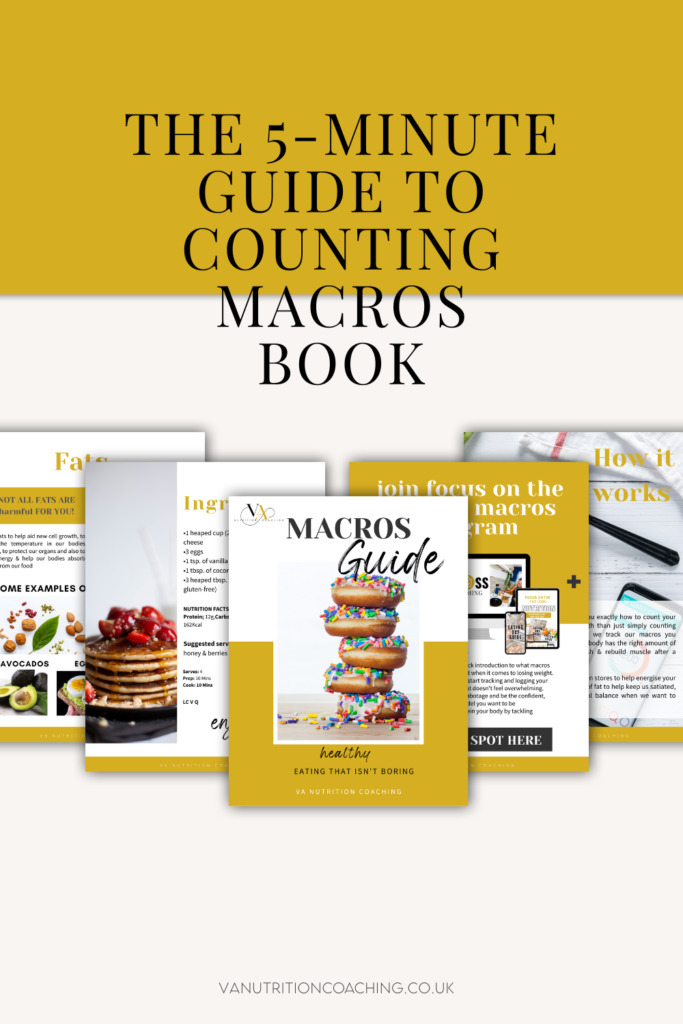Figure out how many calories you’re eating.
In order to figure out how many calories you’re eating, make sure you track your food intake. If you’ve already been tracking your food intake, you can skip ahead. If not, grab your 5 minute macro guide here.

Determine your goal weight and how long it’ll take you to get there.
So you have the right idea to start counting your macros, but you’re not sure how to get started. Well, that’s what we’re here for!
First things first: how do you determine how much weight you want to lose? We recommend using an online calculator like [This] one. It’ll ask you questions about your height, age, gender and activity level (for example, whether or not you work out every day). Then it’ll spit out a recommended goal weight based on those answers.
Keep in mind that this is just a guideline—if it tells you that losing 5 pounds would be healthy for someone who works out five days per week at a moderate intensity level then don’t feel discouraged when all those workouts aren’t helping drop the scale as fast as expected! Next up is figuring out how long it might take before achieving this goal becomes reality. If your target weight loss is 10 pounds over two months then follow these steps:
Figure out your macros.
As we mentioned before, macros are the macronutrients in our food. They’re broken down into protein, carbohydrates and fat. Protein is made up of amino acids—the building blocks of muscle tissue—that help repair damaged muscles after a workout session. Carbohydrates are best known as your brain’s fuel source and also play a role in muscle growth.
Fat is an essential nutrient that plays many roles in your body but gets a bad rap because it’s high in calories; however, there are different types of fats that can help you lose weight if consumed in moderation (more on this later). Once you’ve figured out how much you need each day based on your goals and current nutritional intake, you can start planning meals around these macros!
Track your macro intake, at least for the first couple weeks.
You will likely see better results if you track your macros for the first couple weeks. It’s a good way to get familiar with what your normal eating habits are and it also helps you find out what your ideal macro intake should be. After that, it can be helpful to track them sometimes to make sure that you’re staying on track or making adjustments as needed.
Keep things flexible and make adjustments as you go along.
Don’t agonize over your macronutrient levels. It’s likely that you don’t have perfect ratios, and that’s okay! The important thing is to eat foods that you enjoy as you work your way toward a healthy weight. If you’re finding it hard to make progress in one area, try adjusting another aspect of your diet instead of stressing about the numbers and letting it ruin your day.
Experiment with new foods and spices to find tasty ways of making familiar dishes healthier—and remember that there are no rules for what you can or cannot eat on a given day! If you’re craving something sweet but want to stay on track with your macros, try sprinkling some dark chocolate chips or using honey as a substitute for sugar in baking recipes instead of reaching for high-calorie alternatives like brownies or ice cream (which are off limits anyway).
You want to eat a balanced diet, so pay attention to what you’re eating and make sure you’re getting enough of everything.
At the end of the day, it’s all about balance. You want to eat a balanced diet, so pay attention to what you’re eating and make sure you’re getting enough of everything.
- Eat a variety of foods. Keep in mind that some foods are better for you than others, so don’t just eat whatever’s convenient or tasty.
- If you’ve been having trouble following your diet plan, think about why that might be and how you can improve on it next time around.
- Drink plenty of water throughout the day to stay hydrated and keep your body running smoothly (and also because it makes everything taste better).
Conclusion
In short, you want to make sure you’re getting enough of everything. It’s not a good idea to eat too many carbs or fats, and if you ignore the protein requirement, then your body won’t be able to build muscle at all.
view + leave comments . . .